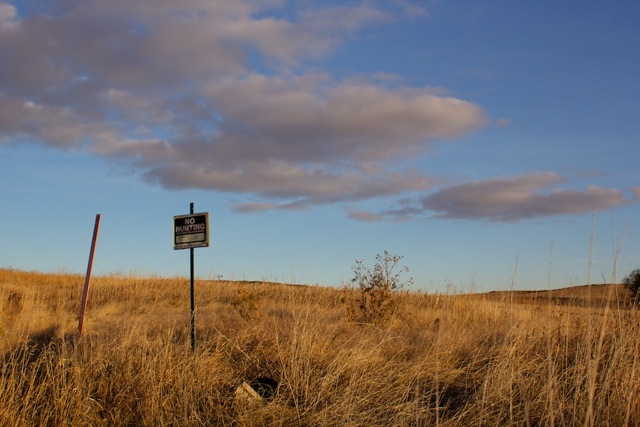Rural.
That's one word that describes a lot of North Dakota. But the picture doesn't always look like this. In fact, from that vantage point, you could spot several oil pumpers - those hydraulic metal machines that look sort of like a fat-beaked bird continually dipping it's snout into the soil - out in the middle of wheat fields, and behind this sign there were miles of pipeline laying on the dirt, waiting to be assembled:
No Hunting. But you can grade a swath of this field and lay a natural gas pipeline.
Natural gas isn't the reason there's a boom in North Dakota. People are getting rich here from oil, which lies within a rock formation called the Bakken, about ten thousand feet beneath the earth's surface. But when the oil is pumped out, after some very precise drilling and hydraulic fracturing, natural gas comes up, too, and can be worth trapping if you have the means to transport it. So far, that's a big if. Most oil companies just burn it off because the infrastructure does not yet exist to transport it, and as a result, most oil wells have flares beside them - a small pipe coming out of the ground with a continuous flame on the end. The flame can range from the size of a small person to the size of a small car. (Tonight, as I was driving across the prairie in the dark, I saw a particularly large flare whipping and lapping in the wind right beside the road, silhouetting an oil storage tank nearby. The flare was so large that I thought the tank was a house on fire, and I changed lanes to avoid it.)
I'll be here three more days. So far, I've run into people who love and hate what oil is doing to this land and the culture. At a bar in Palermo, North Dakota tonight, a woman told me that a few years ago, her town had 75 people including livestock. Today, the town is strewn with campers, RVs, and tank trucks. The bar parking lot had literally nothing but rows of brand new, dusty pick up trucks. Inside, there was a hand-written message taped to the wall that prohibited getting mouthy with the bartender and fighting - a message that would have been meaningless a couple years ago.
Yet residents who aren't profiting from the boom are still trying to hang on. Locals crowded the bar tonight, and it's only Monday. When I sat down, the bartender introduced me to every person there, including the mayor, who was wearing overalls and swore like he was in the navy. A farmer walked in wearing a black cowboy hat and passed around his phone that showed pictures of his new twins on it, born last week eight weeks premature. Over the course of two hours, three different people bought everybody a round of drinks. For a second, you could forget that there was even an oil boom. But then a tank truck rolls past the window on the tiny two-lane highway, and you remember: this is North Dakota, and like it or not, there is one hell of a boom going on.





Thanks Laura! A peek behind the curtains of America....something for us to think about as we zip around outside the black gold boom
ReplyDeletePS I can't see these photos either- but I can see all the rest, including the giant veins on the giant Holstein's udder.
Hey Ann - thanks for your comment. I changed some settings, so hopefully you can now see the pictures. That Holstein, a sign proudly claims, is the largest Holstein in the world. They call her Salem Sue. It was paid for by dairy farmers, so I'm sure the giant veins were a purposeful detail.
ReplyDeleteyay! I can see them now. Is that an airplane trail above the pipes lined out in the 2nd picture? very ironic if it were.... but it could be a cloud- you would know, not I
ReplyDeleteIt does look like an airplane contrail. Pipes below, exhaust above. These broad skies show everything, a captivating realm.
ReplyDelete